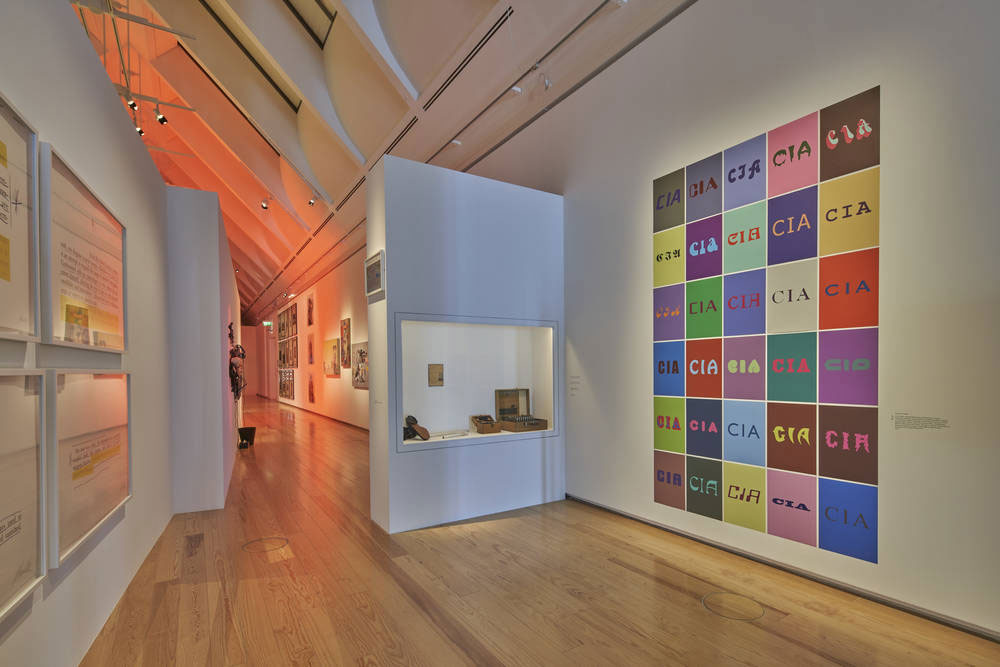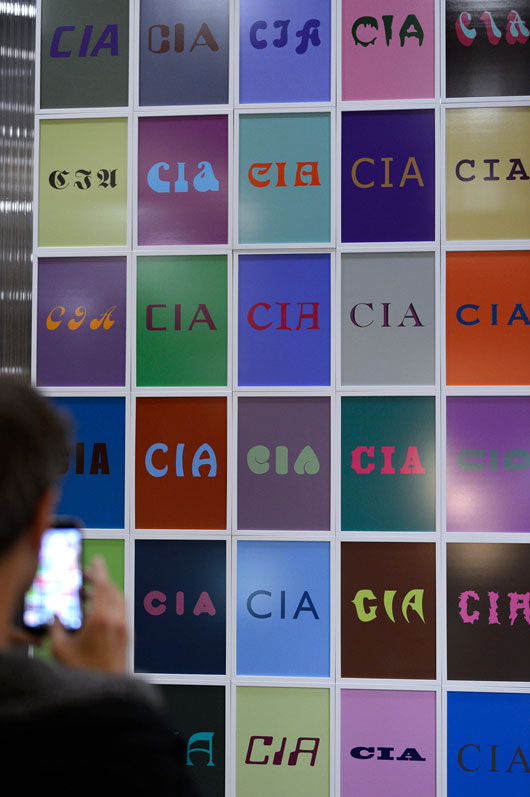Suzanne
Treister
2017
Commission for the exhibition, Parapolitics: Cultural Freedom and the Cold War
Haus der Kulturen der Welt (HKW), Berlin, Germany
(November 3, 2017–January 8, 2018)
Title: CIA/Cruiser, AlienEyeExtended, BubbleSoft, Creeper, Flashback, Berliner, SandCastles, LushlifeExtended, Tahoma, Courier New, Haight, Chainlink, Enchantment, Gravure-Plain, Copperplate, Impact, Hobo Std, Sixties Vibe, LibertySpike, MKUltra, Rosewood Std, Neon, Gill Sans, Slasher, SwampTerror, WavyOrnamental, VanVeen, DigitalMachineExtended, BlackOak Std, Times New Roman
Grid of 30 works
Medium: Archival giclée prints
Dimensions: each work 42 cm x 29.7 cm / total size without frames 148.5 x 252 cm
R: Installation view, HKW, Berlin
This text work presents multi font versions of the acronym CIA, echoing/mirroring the many covert guises (many in publishing and art funding) undertaken by the US Central Intelligence Agency in the political-cultural propaganda operations undertaken by the Congress for Cultural Freedom (CCF). The work translates the name of the Agency into a pop-conceptual artwork, echoing the CIA's advocacy and dissemination of contemporary art as an expression of a free, peaceful, democratic and humane society, whilst the abstraction of the variously signifying fonts returns each time to the source of the propaganda, the name/acronym of the CIA itself.
HKW Press Release: Among the activities highlighted in the article was the Congress for Cultural Freedom (CCF), an organization specifically devoted to the “promotion of the autonomy of artists and intellectuals.” The CCF was founded by a group of writers driven to consolidate an anti-totalitarian intellectual community and it involved many of the New York Intellectuals. The CCF’s inaugural conference opened in June 1950. In 1960, the prominent ten-year anniversary conference was held at the Congress Hall in Berlin, today’s Haus der Kulturen der Welt. Through offices in 35 countries, the CCF subsidized countless cultural programs, from Latin America to Africa and Southeast Asia—developing a network of journals, conferences, and exhibitions that promoted the “universal language of modernism.” The term "parapolitics" refers to the use of soft power in the Cold War, encapsulated in the expression the "battle for Picasso's mind." The activities of the CCF contributed to the resignification of modernism as a way of disseminating a “politics of apolitical culture.” The exhibition is built around the ideological contradictions of this resignification and the moral ambiguities of celebrating cultural freedom and transparency by means that are themselves outside of democratic accountability. The project revolves around the use of art in shoring up an anti-communist consensus, and the strategies of artistic autonomy within this parapolitical choreography. The exhibition features numerous documents and archival material, including the journals and magazines Der Monat (Germany), Encounter (UK), Sasanggye (South Korea), Quest (India), Africa South (South Africa), Black Orpheus (Nigeria), Transition (Uganda / Ghana), The New African (South Africa), Hiwar (Lebanon), and Mundo Nuevo (Latin America), which were either initiated or temporarily supported by the Congress for Cultural Freedom and significantly influenced public opinion in the decades following the Second World War. |
With works by Art & Language, Doug Ashford, Michael Baers, Antonina Baever, Alessandro Balteo-Yazbeck (in collaboration with Media Farzin and Paolo Gasparini), Robert Barry, Romare Bearden, Samuel Beckett, Lene Berg, Broomberg and Chanarin, Fernando Bryce, Daniel Buren, Luis Camnitzer, Alice Creischer, Didactic Exhibition, Liu Ding, Charles and Ray Eames, Miklos Erdély, Peter Friedl, Sheela Gowda, Philip Guston, Gruppe Gummi K, Max de Haas, Chia Wei Hsu, Iman Issa, Voluspa Jarpa, David Lamelas, Jacob Lawrence, Norman Lewis, ?lhan Mimaro?lu, Moiseyev Dance Company, Museum of American Art in Berlin, Solomon Nikritin, Irving Norman, Guillermo Nuñez, Branwen Okpako, Boris Ondrei?ka, Nam June Paik, Décio Pignatari, Howardena Pindel, Sigmar Polke, Rebecca H. Quaytman, Walid Raad, Steve Reich, Ad Reinhardt, Gerhard Richter, Faith Ringgold, Norman Rockwell, Peter Roehr, Martha Rosler, Charles Shaw, Yashas Shetty, Francis Newton Souza, Frank Stella, The Otolith Group, Endre Tót, Suzanne Treister, Twins Seven Seven, Josip Vaništa, Wolf Vostell, and Susanne Wenger Curated by Anselm Franke, Nida Ghouse, Paz Guevara, and Antonia Majaca. Parapolitics: Cultural Freedom and the Cold War is part of Kanon-Fragen. Kanon-Fragen is supported by the Federal Government Commissioner for Culture and the Media due to a ruling of the German Bundestag. Haus der Kulturen der Welt is supported by the Federal Government Commissioner for Culture and the Media as well as by the Federal Foreign Office. |
 Installation at Schirn Kunshtalle, Frankfurt, Germany in the exhibition, We Never Sleep, 24 September 2020 - 10 January 2021 |
|
